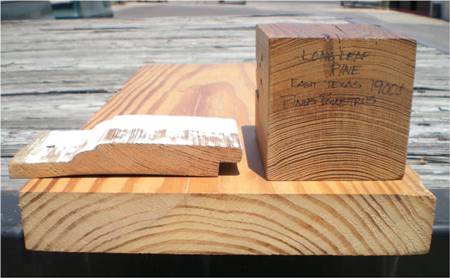In my mind many of the “new” regulations and laws have created a problem for historic preservation.
People who love old houses often talk about why wood in old homes is so important. There are also the Massachusetts lead paint laws. Lead paint often covers this wonderful old growth wood, which is one of the reasons that so many houses are gutted. I thought I would put both an article on why “old-growth” wood lumber is so valuable which is, or has been found in the old homes in Newburyport, along with a summary of the Massachusetts lead paint laws.
Old Growth Wood
Why Old Growth Wood is Better, by Scott Sidler of the Craftsman Blog
“Old-growth wood is lumber that was grown naturally in vast virgin forests. The forests of nearly every continent have some areas that are still untouched where trees haven’t been harvested for our use yet. These trees grew slowly due to limited light and competition from the other trees. Because of this slow growth rate the growth rings on the trees were packed very tightly together which gives the wood some big benefits which I’ll discuss in a just a minute.
In America we began seriously depleting these virgin forests during the industrial revolution and by the 1940s most of them were gone. Lumber prices began to spike as Americans looked for substitutions for our lumber addiction. Enter second-growth and new-growth wood.
Tree farms began to produce lumber for the growing demand and the fastest growing species like Pine were selected for this reason. The trees grew in open areas with little to no competition for sun which caused them to grow very quickly so they could be harvested in 10-20 years as opposed to old-growth wood which may be from trees as old as 200-300 years old before being harvested.
Let’s look back at the picture above. The old-growth siding has 29 growth rings in this 3/4″ thick sample compared with the new-growth piece that has only 7 rings including the pith (the center of the tree). That’s a much faster growth rate, so lets see why this fast growth may not be as good as the slower growth of old-growth wood.
Benefits of old-growth lumber.
1. More Rot-Resistant – Sure we have woods like Pressure Treated and Accoya (which I use often) but old-growth wood is the original rot-resistant wood. The slow growth process creates greater proportion of late wood (summer/fall growth) to early wood (spring growth). Late wood is the good stuff that adds this rot-resistance. Also, older trees develop heartwood at their center which is not only beautiful to the eye, but it is extremely durable and resists rot in ways that other wood can’t.
2. More Stable – Wood moves. It contracts when it’s dry and expands when it’s wet. This can cause joints to open up, paint and finishes to fail prematurely and a host of other issues. But old-growth wood (due to the tight growth rings you can see in the picture above) does not move nearly as much as new-growth. It is immensely more stable and therefore keeps everything where it needs to be from siding and framing to windows and doors.
3. Stronger – The denseness of old-growth wood makes it a much stronger wood able to carry heavier loads across longer spans. The span rating for framing lumber continues to fall each time the lumber industry revisits it. Wood is getting softer and weaker as the years go by so old-growth is definitely worthwhile option especially if you already have it in your house.
4. More Termite-Resistant – Termites don’t like hardwoods. Don’t get me wrong here, termite-resistant is not the same as termite proof. Termites will still eat old-growth wood, but they prefer soft, moist wood (read: easy to chew). Old-growth wood is harder and drier than new lumber and it does not make as tempting a meal for termites.”
Massachusetts Lead Paint Laws
“Massachusetts enacted one of the nation’s first state lead poisoning prevention laws in 1971. The original statute embodied the principle of primary prevention, which remains at the heart of the current law. Since 1971, Massachusetts property owners are required to permanently control specified lead-based paint lead hazards in any housing unit in which a child under the age of six resides. The 1971 law provided for enforcement of this duty by both a newly-created state Childhood Lead Poisoning Prevention Program within the Department of Public Health and by local boards of health. In addition, the law enlisted the help of the tort system for enforcement by providing that property owners would be “strictly liable” for damages resulting from failure to make a child’s apartment lead-safe. (“Strict liability” means that owners are liable even if they didn’t know that lead-based paint hazards were present.)
The law was revised in 1987 in three ways. First, the amendments sought to improve the quality and safety of abatement work by requiring use of trained and licensed contractors, relocation of occupants during abatement, and daily and final cleanup in units undergoing abatement. Second, the amendments were designed to substantially increase the number of units brought into compliance by providing financial assistance (a $1,000 state income tax credit and a grant/loan program) and mandating that prospective purchasers of residential premises receive notice about the lead law and have the opportunity to get an inspection. Finally, the amendments embraced the principle of universal blood lead screening, mandating that physicians screen children and that health insurers cover screening costs.
In 1993, the law was amended further still. Compliance costs were lowered by allowing owners to use interim controls for up to two years before permanently containing or abating lead-based paint hazards. Other cost-reducing provisions allowed the use of encapsulants and eased safety precautions when children would not be endangered. Owners were provided with a larger state income tax credit ($1,500/unit), and a new state fund was set up to provide funds for lead hazard control. Finally, owners who obtain certification from a licensed inspector that interim controls or abatement have been performed are no longer held strictly liable, and insurers are required to provide coverage for any negligence claims (short of gross or willful negligence) that may be brought against such owners.”
(This is just a summary of a very complicated law.)
From the National Center for Healthy Housing
The Massacussetts Lead Paint Laws can be seen here, and here, What Does the Massachusetts Lead Law Require. “The Lead Law requires the removal or covering of lead paint hazards in homes built before 1978 where any children under six live. Lead paint hazards include loose lead paint and lead paint on windows and other surfaces accessible to children. Owners are responsible with complying with the law. This includes owners of rental property as well as owners living in their own single family home. Financial help is available through tax credits, grants and loans.”
In the Property Transfer Lead Paint Notification one of the things that is required is to, “Tell the buyer that, under the Lead Law, a new owner of a home built before 1978 in which a child under six will live or continue to live must have the home either deleaded or brought into Interim Control within 90 days of taking the title.”
De-leading a home is expensive, so it is understandable why a homeowner, even though they might not have a child under six, who will eventually want to resell their home, might not want their home to contain any lead paint. It is also understandable why a developer who is building a home that potentially could be used by a family, would not want that home to contain lead paint.

